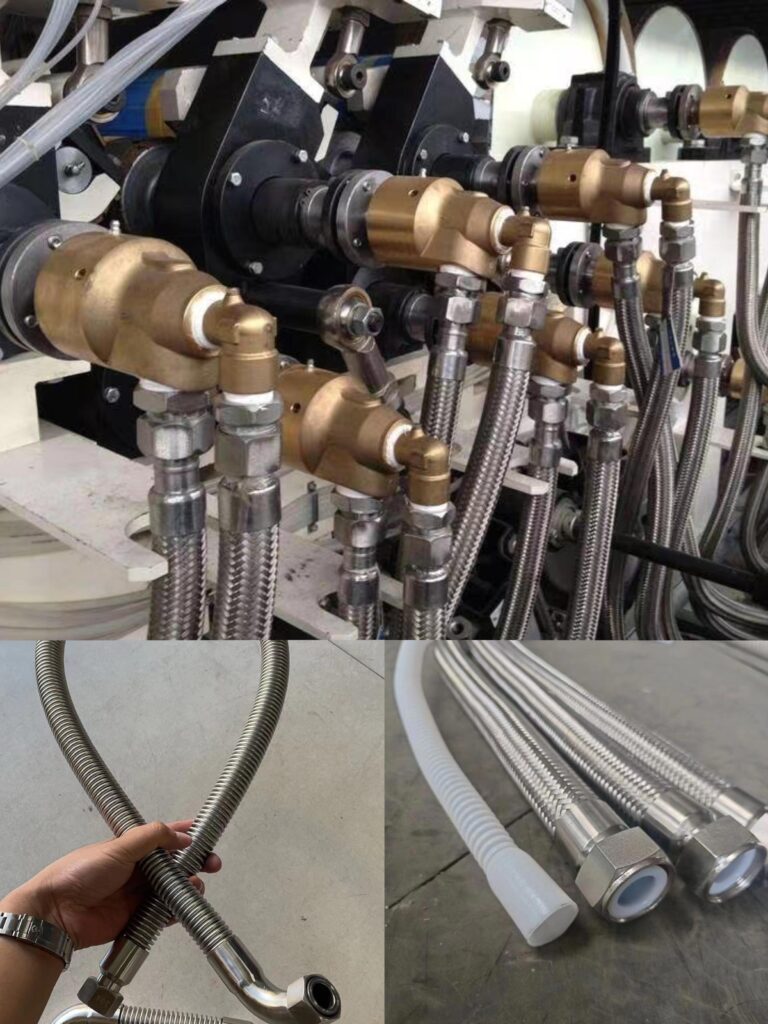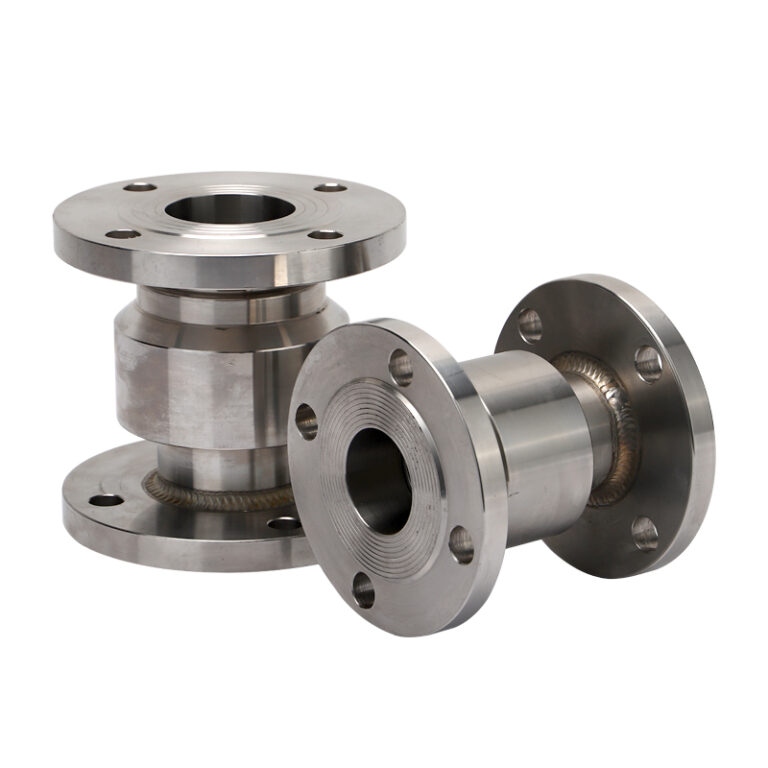HOW A ROTARY UNION WORKS?HOW A ROTARY UNION WORKS?
The rotary joint is a connection sealing device that inputs the fluid medium from the static pipe to the rotating or reciprocating equipment, and then drains from the rotary joint, referred to as the “rotary joint”. The earliest rotary joint was a packing seal, wrapped around the rotating part of the twine or asbestos rope type filler. Due to the long working time to constantly replace the filler, in order to avoid such trouble, so someone invented the sealing wear-resistant parts. This was the prototype of today’s rotary joint. Later, people used flat devices and silicon carbide to effectively solve the problem of flat wear.
Basic Components
1. Stationary Housing: This is the part of the rotary union that remains fixed and is connected to the stationary fluid supply.
2. Rotating Shaft or Drum: This part rotates and is connected to the rotating machinery.
3. Seals: These are critical components that prevent fluid leakage between the stationary and rotating parts.
4. Bearings: These support the rotating shaft and ensure smooth rotation.
5. Internal Passages: Channels within the rotary union that allow the fluid to flow from the stationary side to the rotating side.
How It Works
1. Fluid Entry:
– The fluid enters the stationary housing through an inlet port. This can be a pipe, hose, or other connection method.
2. Seal Interface:
– As the fluid enters, it passes through a seal interface. The seals are designed to maintain a tight, leak-free connection between the stationary and rotating parts. Common types of seals include mechanical seals, lip seals, and O-rings.
3. Rotation:
– The rotating shaft or drum is supported by bearings, which allow it to rotate smoothly. The bearings reduce friction and wear, ensuring long-term reliability.
4. Fluid Transfer:
– The fluid flows through internal passages in the rotary union. These passages are designed to direct the fluid from the stationary side to the rotating side.
5. Exit:
– The fluid exits the rotary union through an outlet port on the rotating side. This port is connected to the rotating machinery, where the fluid is used for various purposes such as cooling, lubrication, or power transmission.
Principle and structure of rotary joint
The working principle of different rotary joints is different. Although the sealing structure of the rotary joint is much the same. Most of them are spring-propelled sealing. However, because the circulation medium is different, the working principle is also different.
In the case of high temperature rotary joint through hot oil, if the rotary joint is installed unilaterally, the two-way rotary joint will be used. It can be accessed simultaneously through a swivel joint. In order to uniform roll temperature, the installation of unilateral bidirectional rotary joint will generally use the inner tube for oil intake, and the hole next to the shell will be used as the oil outlet. The inner tube length is more than half of the roller. Drill some small holes into the tail section of the inner tube. In order to ensure that the oil inside the roller is full. It makes the inner tube bigger and the oil outlet smaller.
If the roller is mounted at both ends, it is even simpler. Just install a swivel joint of the same size. No matter which end comes in or out, it’s the same.
Steam swivel is also called high temperature swivel. The difference is that the steam rotary joint is the side hole as the steam inlet. The inner tube acts as a siphon to drain water. The quality of drainage is directly related to the temperature of the roller. Therefore, the siphon generally uses a hard tube and a hose. The hard tube extends to the inside of the roller, and the hose droops close to the inner wall of the roller. In this way, the condensed water is discharged under the pressure of the steam.
The working principle of the water rotary joint is the same as that of the high temperature thermal oil rotary joint. The two-way rotary joint is installed in one side. The water inlet speed is higher than the outlet speed. Keep the roller always full of water. If one is installed at one end, it is best to enter the water quickly and the water slowly. However, because the water is generally pressurized with a pump, the same rotary joint used at both ends of the same roller will also be fast water and slow water.
structure
Q type rotary joint internal structure: spherical ring (also called sealing ring), column ring (also called support ring), spring, tube ball (rotary joint and equipment connection body) shell. The main function of the spherical ring is to seal. The R surface of a general spherical ring and the sphere of a tube ball form a sealing surface. When the tube ball rotates, it is sealed by friction with the R surface of the spherical ring, also called dynamic seal. The plane of the spherical ring is sealed with the plane of the shell. Because the ball ring and the shell are stationary, it is also called static seal. The column ring is mainly supporting. The outside of the column ring is fitted with the inside of the shell, and the inside of the column ring is fitted with the tube ball. It holds the tube up. The spring is installed under the column ring, using it to push the column ring up against the ball ring, in the case of friction and wear of the ball ring, relying on the spring to compensate the driving force.
The internal structure of the H-type rotary joint is similar to that of the Q-type rotary joint. H-type rotary joint internal structure: H-type ring, O-type ring, stop, spring, hollow shaft, bearing, circlip. The main sealing structure is driven by springs. The plane of the H-ring is sealed with the end face of the hollow shaft. The cone of the H-ring is sealed inside the O-ring. The outer O-ring is sealed against the housing. The bearing is fixed to the hollow shaft with a circlip. Finally, the shaft equipped with bearings is fixed inside the housing with a circlip. Rely on bearings to balance and rotate.
Type D swivel
Internal: Compensator, D-ring (also called flat ring), bushing (fixed D-ring) hollow shaft, bearing. The compensator is composed of bellows and springs, which can not only compensate the sealing effect of the D-ring, but also directly seal the direct contact between the pipeline circulation medium and the shell. The D-ring is held in place by a bushing to ensure that the D-ring does not run off.
Key Features and Benefits
– High Precision: Rotary unions are precision-engineered to ensure minimal leakage and long service life.
– Durable Construction: Made from high-quality materials such as stainless steel and brass, with options for silicon carbide seals for applications involving abrasive or corrosive media.
– Multiple Channels: Available in single and multi-channel configurations to handle different fluids simultaneously.
– Wide Temperature and Pressure Range: Capable of operating under a wide range of temperatures and pressures, making them suitable for diverse industrial applications.
– Customization: Can be tailored to meet specific application needs, including different mounting styles and special material requirements.
Applications
– Machine Tools: For coolant and lubricant delivery to cutting tools.
– Paper Mills: For transferring steam, water, and other fluids.
– Plastic Processing: For cooling and heating molds.
– Textile Industry: For dyeing and finishing processes.
– Aerospace and Defense: For hydraulic and pneumatic systems.
– Food and Beverage: For cleaning and sterilization processes.
– Wind Energy: For pitch control systems in wind turbines.
– Automotive and Aerospace Manufacturing**: For fluid transfer in manufacturing processes.
Maintenance and Care
– Regular Inspection: Check for leaks, wear, and damage.
– Lubrication: Ensure proper lubrication of seals and bearings.
– Cleaning: Keep the union and surrounding area clean to prevent contamination.
– Replacement of Worn Parts: Replace worn or damaged seals and bearings.
– Pressure Testing: Periodically test the union for leaks and proper function.
By understanding these components and how they work together, you can better appreciate the role of rotary unions in various industrial applications. If you have any specific questions or need further details, feel free to ask!








